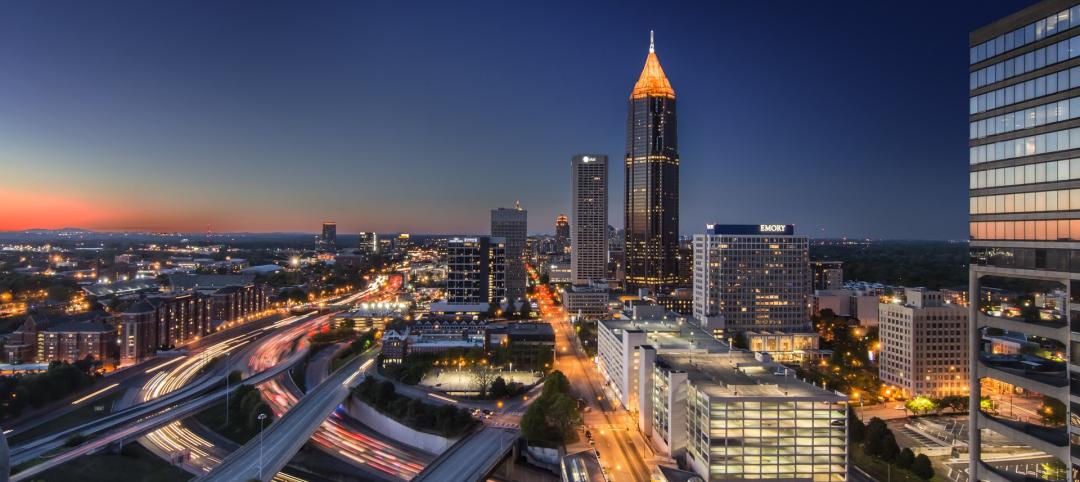In 1918, the actor-producer Henry Miller borrowed from friends and hired architects Paul R. Allen and Ingalls & Hoffman to build a 950-seat theater in neo-Georgian style. It was the first theater on Broadway to be air-conditioned.
Henry Miller's Theatre had its first hit in 1926 with Noel Coward's "The Vortex." Miller died later that year, and his son, Gilbert, took over. The venue enjoyed success through the 1960s, with performances by the likes of Helen Hayes, Douglas Fairbanks, and Leslie Howard.
The theater was sold to Seymour Durst in 1968, after which it went through various incarnations--as film house, porn palace, discotheque, and back to legitimate theater in 1988. It closed in 2004, around the time that the Durst Organization, now led by Seymour's son, Douglas, formed a joint venture with Bank of America, N.A., to build a two-million-square-foot LEED Platinum office building at One Bryant Park. The theater building was to be part of that project.
However, state officials determined that the theater structure itself had to be demolished because it could not be brought into compliance with New York City fire codes or the Americans with Disabilities Act. The exception was the historic facade, which state historic preservation officials ruled had to be saved at all costs. They also threw in another requirement: The height of the new theater could not exceed that of the old facade. The only way to do that would be to sink the new structure in the space behind the old facade.
The technical question that loomed over the Building Team, therefore, was this: Could they dig the deepest excavation in midtown Manhattan--70 feet below street level--without damaging the landmark facade? For the Durst Organization and Bank of America, this was no joke: they could incur millions in damages should the wall come tumbling down.
Structural engineer Severud Associates designed an elaborate three-story structural steel support frame to hold the wall up. The design had to be approved by the Empire State Development Corporation, which insisted that anchors could not be attached to the outside face of the wall. Severud and subcontractor Regional Scaffolding & Hoisting Co., Bronx, N.Y., overcame this problem by reaching the bracing through the existing window openings and anchoring the braces to the inside face.
The real worry was vibration--from workers attaching the support for the facade, even as they were detaching the facade from the old structure; from the demolition of the old theater; and from the excavation of the foundation pit for the theater and the skyscraper. The threshold for the vibrations was very low due to the old and partly unknown composition of the facade. The team determined that the maximum peak particle velocity could not exceed 0.5 inches per second. To check this, they installed wireless vibration and tilt monitors on the facade to provide instantaneous data by email so that Tishman Construction project managers and the structural engineers would know in seconds if something untoward was happening with the wall.
The demolition job itself was no picnic. The foundation had to be excavated deeper than usual to make room for the theater's back-of-the-house spaces (dressing rooms, etc.), the orchestra and mezzanine section, and building utilities; all this had to be sunk deep into the bedrock to keep the new theater from projecting above the historic facade, as required by the preservation authorities. The facade had to be underpinned during excavation, and the underpinning had to be secured with rock anchors. The contractor cut openings in the back side of the facade for new structural support columns. Bank of America Tower and the new theater were erected adjacent to the facade; then the facade was connected to the podium of new structure.
Meeting social needs
The judges were impressed with the Building Team and owner's sensitivity to the many social concerns raised in innumerable meetings with community boards, local planning organizations, theater companies, the Municipal Art Society, the New York Landmarks Conservancy, the New York State Historic Preservation Office, the Empire State Economic Development Corporation, the Mayor's Office, the city's Commissioner of Culture, and even the Natural Resources Defense Council, which coordinates the "Broadway Goes Green" program.
As a result of these consultations, the new theater went beyond the usual Broadway standard and added three times the code-required number of women's restroom facilities. In addition to the 20 ADA-mandated viewing stations, the team provided an additional restroom and drinking fountain for wheelchair users.
With regard to minority- and women-owned business involvement, Tishman exceeded the Empire State Development Corporation's target of 18% M/WBE participation by more than 12 percentage points. The construction manager also pushed its subcontractors hard on their hiring practices, a process that enabled the project to meet the goal of a 20% minority/women labor force.
The project is seeking LEED Gold status from the Green Building Certification Institute and is already the greenest theater on Broadway.
Henry Miller's Theatre reopened last November and is now operated by the Roundabout Theatre Company, which had a significant role in providing input to the design team on stage and orchestra design, sightlines, production lighting, and other aspects of performance-based design. Last March 22, it was renamed the Stephen Sondheim Theatre on the occasion of the composer-lyricist's 80th birthday.
One of my favorite Sondheim numbers is "The Madam's Song." Known popularly as "I Never Do Anything Twice," it goes like this:
Once, yes, once for a lark / Twice, though, loses the spark / But, no matter the price / I never do anything twice.
Theatergoers can be glad that the Durst Organization, Bank of America, and their Building Team chose to defy the song's proscription. They gave it another go and, without any loss of spark, successfully--no, magnificently--restored legitimate theater to this corner of West 43rd Street. It's grand to have the ol' gal back, and in such fine form. BD+C
PROJECT SUMMARY
Bronze Award
Stephen Sondheim Theatre (formerly Henry Miller's Theatre)
New York, N.Y.
Building Team
Submitting firm: Tishman Construction Corp. (CM)
Owner: One Bryant Park, LLC (joint venture of The Durst Organization and Bank of America, N.A.)
Design architect: Cook + Fox Architects
Executive architect: Adamson Associates Architects
Structural engineer: Severud Associates Consulting Engineers
Excavation and foundations: Civetta-Cousins JV
Mechanical/electrical engineer: Jaros Baum & Bolles
Theater consultant: Fisher Dachs Associates
Acoustic/AV consultant: Jaffe Holden Acoustics, Inc.
Historic preservation consultant: Higgins Quasebarth & Partners, LLC
General Information
Project size: 67,900 sf (1,055 seats)
Construction cost: Confidential, at owner's request
Construction time: April 2004 to May 2009
Delivery method: CM
Related Stories
Adaptive Reuse | Sep 12, 2024
White paper on office-to-residential conversions released by IAPMO
IAPMO has published a new white paper titled “Adaptive Reuse: Converting Offices to Multi-Residential Family,” a comprehensive analysis of addressing housing shortages through the conversion of office spaces into residential units.
Mixed-Use | Sep 10, 2024
Centennial Yards, a $5 billion mixed-use development in downtown Atlanta, tops out its first residential tower
Centennial Yards Company has topped out The Mitchell, the first residential tower of Centennial Yards, a $5 billion mixed-use development in downtown Atlanta. Construction of the apartment building is expected to be complete by the middle of next year, with first move-ins slated for summer 2025.
Healthcare Facilities | Sep 9, 2024
Exploring the cutting edge of neuroscience facility design
BWBR Communications Specialist Amanda Fisher shares the unique considerations and challenges of designing neuroscience facilities.
Office Buildings | Sep 6, 2024
Fact sheet outlines benefits, challenges of thermal energy storage for commercial buildings
A U.S. Dept. of Energy document discusses the benefits and challenges of thermal energy storage for commercial buildings. The document explains how the various types of thermal energy storage technologies work, where their installation is most beneficial, and some practical considerations around installations.
Office Buildings | Sep 5, 2024
Office space downsizing trend appears to be past peak
The office downsizing trend may be past its peak, according to a CBRE survey of 225 companies with offices in the U.S., Canada, and Latin America. Just 37% of companies plan to shrink their office space this year compared to 57% last year, the survey found.
University Buildings | Sep 4, 2024
UC San Diego’s new Multidisciplinary Life Sciences Building will support research and teaching in both health and biological sciences
The University of California San Diego has approved plans for a new Multidisciplinary Life Sciences Building, with construction starting this fall. The 200,000-sf, six-level facility will be the first building on the UC San Diego campus to bridge health science research with biological science research and teaching.
Codes and Standards | Sep 3, 2024
Atlanta aims to crack down on blighted properties with new tax
A new Atlanta law is intended to crack down on absentee landlords including commercial property owners and clean up neglected properties. The “Blight Tax” allows city officials to put levies on blighted property owners up to 25 times higher than current millage rates.
Resiliency | Sep 3, 2024
Phius introduces retrofit standard for more resilient buildings
Phius recently released, REVIVE 2024, a retrofit standard for more resilient buildings. The standard focuses on resilience against grid outages by ensuring structures remain habitable for at least a week during extreme weather events.
Construction Costs | Sep 2, 2024
Construction material decreases level out, but some increases are expected to continue for the balance Q3 2024
The Q3 2024 Quarterly Construction Insights Report from Gordian examines the numerous variables that influence material pricing, including geography, global events and commodity volatility. Gordian and subject matter experts examine fluctuations in costs, their likely causes, and offer predictions about where pricing is likely to go from here. Here is a sampling of the report’s contents.
Adaptive Reuse | Aug 29, 2024
More than 1.2 billion sf of office space have strong potential for residential conversion
More than 1.2 billion sf of U.S. office space—14.8% of the nation’s total—have strong potential for conversion to residential use, according to real estate software and services firm Yardi. Yardi’s new Conversion Feasibility Index scores office buildings on their suitability for multifamily conversion.

















